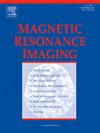Quantification of tissue stiffness with magnetic resonance elastography and finite difference time domain (FDTD) simulation-based spatiotemporal neural network
IF 2.1
4区 医学
Q2 RADIOLOGY, NUCLEAR MEDICINE & MEDICAL IMAGING
引用次数: 0
Abstract
Quantification of tissue stiffness with magnetic resonance elastography (MRE) is an inverse problem that is sensitive to noise. Conventional methods for the purpose include direct inversion (DI) and local frequency estimation (LFE). In this study, we propose to train a spatiotemporal neural network using MRE data simulated by the Finite Difference Time Domain method (FDTDNet), and to use the trained network to estimate tissue stiffness from MRE data. The proposed method showed significantly better robustness to noise than DI or LFE. For simulated data with signal-to-noise ratio (SNR) of 15 dB, tissue stiffness by FDTDNet had mean absolute error of 0.41 kPa or 7 %, 77.8 % and 84.4 % lower than those by DI and LFE respectively (P < 0.0001). For a homogeneous phantom with driver power decreasing from 30 % to 5 %, FDTDNet, DI and LFE provided stiffness estimates with deviation of 6.9 % (0.21 kPa), 9.2 % (0.28 kPa) and 45.8 % (1.20 kPa) of the respective stiffness level at driver power of 30 %. Detectability of small inclusions in estimated stiffness maps is also critical. For simulated data with inclusions of radius of 0.31 cm, FDTDNet achieved contrast-to-noise ratio (CNR) of 4.20, 6900 % and 347 % higher than DI and LFE respectively (P < 0.0001), and structural similarity index (SSIM) of 0.61, 27 % and 177 % higher than DI and LFE respectively (P < 0.0001). For phantom with inclusion of radius 0.39 cm, CNR of FDTDNet was 2.98, 90 % and 80 % higher than DI and LFE respectively (P < 0.0001) and SSIM was 0.80, 89 % and 28 % higher than DI and LFE respectively (P < 0.0001). We also demonstrated the feasibility of FDTDNet in MRE data acquired from calf muscles of human subjects. In conclusion, by using a spatiotemporal neural network trained with simulated data, FDTDNet estimated tissue stiffness from MRE with superior noise robustness and detectability of focal inclusions, therefore showed potential in precisely quantifying MRE of human subjects.
基于磁共振弹性成像和时域有限差分仿真的时空神经网络定量组织刚度
用磁共振弹性成像(MRE)定量组织刚度是一个对噪声敏感的逆问题。传统的方法包括直接反演(DI)和局部频率估计(LFE)。在这项研究中,我们提出使用时域有限差分法(FDTDNet)模拟的MRE数据训练一个时空神经网络,并使用训练好的网络从MRE数据中估计组织刚度。该方法对噪声的鲁棒性明显优于DI和LFE方法。对于信噪比为15 dB的模拟数据,FDTDNet的组织刚度平均绝对误差为0.41 kPa,分别比DI和LFE方法低7%、77.8%和84.4% (P <;0.0001)。对于驱动功率从30%下降到5%的均匀体,FDTDNet、DI和LFE提供的刚度估计偏差分别为驱动功率为30%时的6.9% (0.21 kPa)、9.2% (0.28 kPa)和45.8% (1.20 kPa)。在估计的刚度图中检测小夹杂物也是至关重要的。对于包体半径为0.31 cm的模拟数据,FDTDNet的噪比(CNR)分别比DI和LFE高4.20%、6900 %和347% (P <;0.0001),结构相似指数(SSIM)分别比DI和LFE高0.61、27%和177% (P <;0.0001)。对于半径为0.39 cm的幻体,FDTDNet的CNR分别比DI和LFE高2.98%、90%和80% (P <;0.0001), SSIM分别比DI和LFE高0.80、89%和28% (P <;0.0001)。我们还证明了FDTDNet在人类受试者小腿肌肉的MRE数据中的可行性。综上所述,FDTDNet通过模拟数据训练的时空神经网络,从MRE中估计组织刚度,具有较好的噪声鲁棒性和病灶包涵体的可检测性,因此在精确量化人类受试者的MRE方面具有潜力。
本文章由计算机程序翻译,如有差异,请以英文原文为准。
求助全文
约1分钟内获得全文
求助全文
来源期刊

Magnetic resonance imaging
医学-核医学
CiteScore
4.70
自引率
4.00%
发文量
194
审稿时长
83 days
期刊介绍:
Magnetic Resonance Imaging (MRI) is the first international multidisciplinary journal encompassing physical, life, and clinical science investigations as they relate to the development and use of magnetic resonance imaging. MRI is dedicated to both basic research, technological innovation and applications, providing a single forum for communication among radiologists, physicists, chemists, biochemists, biologists, engineers, internists, pathologists, physiologists, computer scientists, and mathematicians.
 求助内容:
求助内容: 应助结果提醒方式:
应助结果提醒方式:


